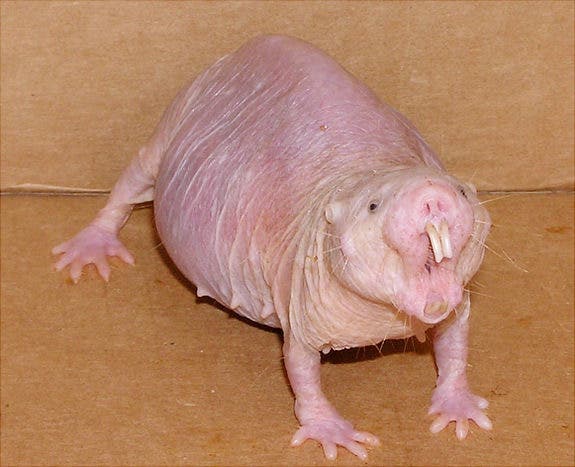Naked mole-rats are known for their, um, interesting appearance, but it turns out they are of interest to scientists for other reasons (such as being able to live without oxygen for 18 minutes). They live in social colonies (somewhat similar to bees) and the queen and king actually live the longest in the colony, despite carrying the entire colony’s reproductive costs. This defies what we know to be true in almost every other animal: reproduction decreases lifespan. Researchers from the Leibniz Institute on Aging in Germany examined their genetics to find out why.
Naked mole-rats live in colonies comprised of a breeding pair (the king and queen, who are the only ones that reproduce) and up to 300 sterile workers. The king and queen are fertile from the age of one until their deaths, and they can live for up to 18 years. The sterile workers gather food, take care of the young, and maintain and guard the nest. When the king and queen die, other members of the eusocial colony take over and sexually mature.

“Our results indicate that when naked mole-rats mature into breeders, it changes their aging rates, meaning that breeders are able to live longer than non-breeders. This is surprising, as evidence from other species suggest that reproduction, which ensures the survival of the species as a whole, reduces the lifespan of the individual. In naked mole-rats reproduction appears to prolong the breeders’ lifespan. This goes against the common expectation that mammals either invest resources in a long life or in reproduction,” said the corresponding author Dr. Martin Bens.
The researchers compared the genes for a range of organs in breeding and nonbreeding naked mole-rats, as well as for guinea pigs, which are close relatives. Aging related genes in breeding mole-rats were differentially expressed as compared to nonbreeding mole-rats and guinea pigs. For example, a muscle regeneration gene is more strongly expressed in breeding naked mole-rats. These differences may be responsible for the long lifespan of breeders.
Interestingly, there were no differences between male and female workers. However, a big difference arises if they become breeders. When the researchers took a male and female worker from the colony and put them together in a separate place, they changed into breeders. They suddenly became sexually dimorphic and had the associated changes in gene expression tied to increased lifespan and health. Becoming sexually active actually changes them at a molecular level! They then get a load of health benefits — presumably to help them maintain a colony.
Journal reference: Bens et al. Naked mole-rat transcriptome signatures of socially-suppressed sexual maturation and links of reproduction to aging. BMC Biology 2018. DOI: 10.1186/s12915-018-0546-z


